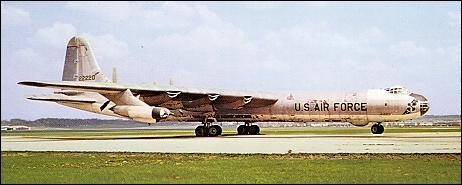CONVAIR B-36J
The B-36, an intercontinental bomber, was designed during WW II. The airplane made its
maiden flight on August 8, 1946 and on June 26, 1948 the Strategic Air Command received
its first B-36 for operational use. By August 1954, when production ended, more than 380
B-36s had been built for the USAF. In 1958-59, the B-36 was replaced by the more modern
B-52.
SPECIFICATIONS:
Span: 230 ft.
Length: 162 ft. 1 in.
Height: 46 ft. 9 in.
Weight: 410,000 lbs. loaded
Armament: Sixteen M24 20mm cannons in eight nose, tail and fuselage
turrets; plus bombs--nuclear or 86,000 lbs. of conventional
Engines: Six Pratt & Whitney R-4360s of 3,800 hp. ea. and four General Electric J47s
of 5,200 lbs. thrust ea.
Cost: $3,701,000
PERFORMANCE:
Maximum speed: 435 mph.
Cruising speed: 230 mph.
Range: 10,000 miles
Service Ceiling: 45,700 ft. |

